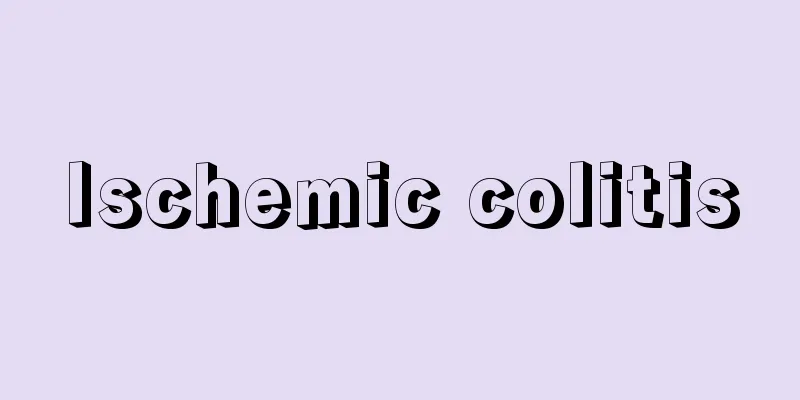Ischemic colitis

|
concept - Frequency Colitis caused by reversible vascular disorder without obvious obstruction of the main arteries. Since its report by Boley et al. in 1963, it has been known as a clinically frequent disease that accounts for more than half of cases of gastrointestinal ischemia. It is more common in the elderly, with about 90% of cases being over 60 years old, but it can also occur in young people around 20 years old. There is no epidemiological difference between men and women. Marston (1966) divided the disease into transient, stenotic, and gangrenous types. Most cases (about 65%) are mild, transient types in which damage is limited to the mucosa and submucosa, but there are also cases in which stenosis is caused by fibrosis of the submucosa (stenotic type, about 25%) and intestinal necrosis (gangrene type, about 10%). Unlike the other two types (non-gangrene type), the gangrenous type causes irreversible intestinal infarction, so in daily clinical practice it is generally excluded from the concept of ischemic colitis (narrow sense). Pathogenesis and risk factors Vascular and intestinal factors are thought to be involved in the development of this condition through a complex interplay between each other. Specifically, vascular factors include intestinal small vessel lesions and microcirculatory disorders due to hypoperfusion, while intestinal factors include smooth muscle spasm due to increased intestinal pressure and hypermotility (Table 8-5-24). Possible underlying diseases that cause intestinal circulatory disorders include systemic circulatory failure, heart failure, arteriosclerosis, and localized microthrombi and embolism, but in many cases, the cause is unknown and non-occlusive ischemia of small vessels that is not detected by angiography. It is also known as a complication after aortic aneurysm surgery, accounting for 10% of deaths. When it occurs in young people, causes include vasculitis, thrombosis, coagulation disorders, drugs, and marathon running. In women, caution is required in the presence of autoimmune diseases such as antiphospholipid syndrome and systemic lupus erythematosus, and in the use of oral contraceptives. There have also been reports of this condition occurring as a result of taking large amounts of diet pills. Intestinal factors include increased intestinal pressure due to constipation, straining, laxatives, and enemas, as well as increased intestinal motility and intestinal stenosis due to colon cancer. The majority of affected areas and clinical symptoms (over 85%) occur in the left hemicolon, mainly from the splenic flexure of the transverse colon to the descending and sigmoid colon, with only the right side of the colon occurring in approximately 15% of cases. Localized non-obstructive reduced blood flow frequently occurs in the water shed area (the watershed of vascular supply) between the splenic flexure and the sigmoid-rectal junction. Rectal lesions are relatively rare. In cases accompanied by systemic hemodynamic changes, particularly in dialysis patients and those in a state of shock, damage to the right colon is often reported, and clinically this condition cannot be distinguished from non-occlusive mesenteric artery ischemia [⇨8-5-22)]. Typical symptoms of ischemic colitis are the sudden onset of severe abdominal pain followed by an increase in the frequency of bowel movements (watery diarrhea) and the appearance of bloody stools within 24 hours. It is often accompanied by vomiting and cold sweats. Abdominal pain is most prevalent in the left side of the abdomen and lower abdomen, and tenderness is also present. In right-sided colonic ischemia, there is little blood in the stool and severe abdominal pain. If abdominal symptoms do not improve and peritoneal irritation symptoms appear, gangrenous type should be considered. In stricture type, subjective symptoms improve initially, but as the stenosis progresses, symptoms of intestinal obstruction become apparent. Diagnosis, test results, and differential diagnosisIf this disease is suspected, a colonoscopic examination should be performed within 48 hours after confirming that there are no abnormal findings or symptoms of peritoneal irritation on plain abdominal X-rays, or a combination of a colonoscopic fiberscope and a barium enema using a water-soluble contrast agent. Barium enema X-ray findings show thumb-printing due to submucosal edema in the acute phase, followed by longitudinal ulcers and lateral deformation. Colonoscopy shows severe edema and congestion in the acute phase, as well as segmental bleeding from the mucosa and submucosa (hemorrhagic nodules), longitudinal ulcers, and erosions (Figure 8-5-36). Characteristic findings in the acute phase include degeneration, loss, and necrosis of the mucosal epithelium, regeneration, bleeding, and exudate, and hemosiderin phagocytes are seen in the chronic phase. The ulcer runs longitudinally along the taenia coli, but in the transient type it is relatively shallow (up to Ul-II), whereas in the stenotic type it extends below the muscular layer. Thumb-printing and hemorrhagic nodules are important findings, but they often disappear within 48 hours, so re-examination should be done one week later. If active inflammation or ulcers remain at this time, other diseases such as inflammatory bowel disease should be suspected. The progression to the stenotic type, in which tubular stenosis or sac formation occurs due to ulcer scarring during the healing phase, is difficult to predict in the acute phase, and follow-up for nearly two months is necessary. Abdominal contrast CT scans and ultrasound scans are also useful in the early differentiation of abdominal pain, and can capture images of intestinal dilation accompanied by thickening of the intestinal wall. Abdominal angiography is not useful for diagnosing this disease because blood flow is usually restored at the time of onset, but is indicated if lesions are also found in the right colon. Blood tests show an increase in white blood cells from the beginning of the onset of the disease, and high inflammatory response values such as CRP and erythrocyte sedimentation rate are observed, which return to normal within 2 to 4 weeks, but those with stenotic type require longer to return to normal. It is necessary to differentiate this from drug-induced colitis, infectious colitis, diverticulitis, ulcerative colitis, and Crohn's disease. It is particularly important to differentiate this from the first two, and it is advisable to ask about the patient's medical history of drug use and perform stool bacterial cultures in all cases (especially for Salmonella, Escherichia coli, Campylobacter, etc.). Treatment and prognosis: If gangrenous colitis is suspected and symptoms of peritonitis appear, emergency surgery is indicated. In non-gangrenous colitis, conservative treatment is performed, including fasting, discontinuation of antiarrhythmic drugs, and administration of fluid replacement and broad-spectrum antibiotics. Lactic acid bacteria preparations are used in mild cases, and antispasmodics and analgesics are used appropriately in moderate to severe cases. In transient cases, symptoms usually disappear within 1-2 days, and colon findings improve with 1-2 weeks of treatment. Diet is resumed after abdominal pain and bloody stool have disappeared. In stenotic colitis, symptoms of stenosis usually gradually improve, but fibrous stenosis occurs, and if severe obstruction symptoms appear after several months, endoscopic dilation therapy or surgery is indicated. In some cases, segmental ulcerating colitis persists, causing repeated fever, diarrhea, and bloody stool, making it difficult to distinguish from inflammatory bowel disease. Caution is required in this case, as the use of steroids increases the risk of perforation. In general, most cases improve with conservative therapy and have a good prognosis, but recurrence occurs in about 5-10% of cases. Gangrenous type may require emergency surgery, and the prognosis is not as good as that of non-gangrenous type. [Soichiro Miura] ■ References Boley SJ, Schwartz S, et al: Reversible vascular occlusion of the colon. Surg Gynecol Obstet, 116: 53-60, 1963. Green BT, Tendler DA: Ischemic colitis: a clinical review. South Med J, 98: 217-222, 2005. Causes of ischemic colitis Table 8-5-24 Source : Internal Medicine, 10th Edition About Internal Medicine, 10th Edition Information |
|
概念 ・頻度 主幹動脈に明らかな閉塞がなく,可逆的な血行障害に起因した大腸炎である.Boleyらにより1963年に報告されて以来,消化管虚血の過半数以上を占める臨床的に頻度の高い疾患として知られる.高齢者に好発し約90%は60歳以上であるが,ときに20歳前後の若年者における発症もみられる.疫学的に男女差はみられない.Marston(1966)は,病型を一過性型,狭窄型および壊疽型に分けた.多く(約65%)は粘膜から粘膜下層までに傷害がとどまる軽症の一過性型であるが,粘膜下層の線維化により狭窄を残すもの(狭窄型,約25%)や腸管壊死に陥る壊疽型(約10%)もみられる.壊疽型はほかの2型(非壊疽型)と異なり不可逆的な腸梗塞をきたすので,日常臨床では虚血性大腸炎(狭義)の概念より除外するのが一般的である. 発症機序・危険因子 血管側因子と腸管側因子が互いに関与して複雑に絡み合い発症すると考えられる. すなわち血管側因子として腸管の小血管病変や低灌流に伴う微小循環障害,腸管側因子として腸内圧の亢進や運動亢進による平滑筋の攣縮があげられる(表8-5-24).腸管の循環障害をきたす基礎疾患として,全身的循環不全や心不全,動脈硬化,局所的な微小な血栓や塞栓が考えられるが,多くは原因不明で血管造影では認識されないような小血管の非閉塞性虚血が考えられる.また大動脈瘤手術後の合併症としても知られ死因の10%を占める.若年者で発症した場合は,血管炎,血栓性素因や凝固異常,薬物によるもの,マラソンなどが原因としてあげられる.女性では抗リン脂質抗体症候群や全身性エリテマトーデスなどの自己免疫疾患の合併や,経口避妊薬などの服用に注意する.やせ薬の大量服用により本症をきたした報告もみられる.腸管側因子として,便秘,いきみ,下剤,浣腸など腸管内圧上昇が誘発因子となり,そのほかに腸管の運動亢進,大腸癌などによる腸管狭窄などがあげられる. 罹患部位・臨床症状 大部分(85%以上)が横行結腸脾湾曲部から下行結腸およびS状結腸を中心とした左半結腸に発生し,右側の結腸のみのものは15%程度にすぎない.局所的な非閉塞性の血流低下は,water shed area(血管支配の分水嶺)である脾湾曲部とS状結腸直腸移行部に高頻度に発生する.直腸病変は比較的まれである.全身の循環動態変化を伴うもの,特に透析患者やショック状態では右側結腸に障害をきたす場合も多いとされ,臨床的に非閉塞性腸間膜動脈虚血症【⇨8-5-22)】と区別できない. 虚血性大腸炎の典型的な症状は,突然に生じる強い腹痛と,それに引き続く排便回数の増加(水様下痢便)と24時間以内の血便の出現が3主徴として典型的である.嘔吐や冷汗を伴う場合が多い.腹痛は左側腹部から下腹部に多く,圧痛を認める.右側結腸型では下血が少なく,腹痛が強い.腹部症状が回復せず腹膜刺激症状が出現した場合は壊疽型を考慮に入れる.狭窄型はいったん自覚症状が改善するが,狭窄の進行とともに腸閉塞症状を認めるようになる. 診断・検査成績・鑑別診断 本症を疑った場合,腹部単純X線検査における異常所見や腹膜刺激症状がないことを確認して48時間以内に大腸ファイバースコープ,あるいはS状結腸ファイバースコープと水溶性造影剤による注腸X線造影の組み合わせによる検査を施行する.注腸X線所見では,急性期に粘膜下層の浮腫により母指圧痕像(thumb-printing)を認め,その後縦走潰瘍や偏側性変形を認める.大腸内視鏡では急性期に浮腫・うっ血が強く,区域性の粘膜や粘膜下層よりの出血(hemorrhagic nodule)および縦走潰瘍やびらんをみる(図8-5-36).急性期では粘膜上皮の変性・脱落・壊死,再生,出血,滲出物など特徴的所見がみられ,慢性期にはヘモジデリン貪食細胞を認める.潰瘍は結腸ヒモに沿って縦走するが,一過性型では比較的浅く(Ul-IIまで),狭窄型では筋層以下に及ぶ.thumb-printingとhemorrhagic noduleは重要所見であるが48時間以内に消失することも多いので,1週間後にもう一度再検する.その際に活動性の炎症や潰瘍が残存していた場合は炎症性腸疾患など他疾患を疑う.治癒期に潰瘍瘢痕により管状狭窄や小囊形成をきたす狭窄型への移行は急性期には予測困難であり2カ月近い経過の追跡が必要である.腹部造影CT検査や超音波検査も腹痛の初期鑑別に有用であり,腸管壁の肥厚を伴う腸管拡張像をとらえることができる.腹部血管造影は発症時に通常血流は回復しているので本症診断には役立たないが,右側結腸にも病変を認めた場合には適応となる. 血液検査では発症当初から白血球が増加し,CRP・赤沈など炎症反応高値を認め2〜4週以内に正常化するが,狭窄型の方が正常に復するまでの時間を要する. 薬物性大腸炎,感染性大腸炎,大腸憩室炎,潰瘍性大腸炎やCrohn病を鑑別する必要がある.特に前2者との鑑別は重要であり,薬物服用の既往歴を聴取し,全例において便の細菌培養(特にサルモネラ,大腸菌,カンピロバクターなど)を施行することが望ましい. 治療・予後 壊疽型が疑われ腹膜炎症状が出現したら緊急手術の適応となる.非壊疽型では絶食とし抗不整脈薬などを中止し,補液,広域抗生物質投与など保存療法を行う.軽症では乳酸菌製剤を,中等症以上では鎮痙薬や鎮痛薬を適宜使用する.一過性型は通常1〜2日で症状が消え,1〜2週間の治療で大腸所見は改善する.腹痛や下血が消失したのち食事を開始する.狭窄型では通常は狭窄症状も除々に解除されるが,線維性狭窄が生じるため数カ月以上経過して強い閉塞症状があれば内視鏡的拡張療法あるいは手術適応となる.なかには区域性の潰瘍病変(segmental ulcerating colitis)が持続して発熱,下痢,下血を繰り返し炎症性腸疾患との区別が困難な場合もあるが,これはステロイドの使用で穿孔の危険性を増すので注意すべきである. 一般的には多くの症例は保存的に軽快し予後良好な疾患であるが,ときに再発を5〜10%程度認める.壊疽型では緊急手術が必要な場合があり,予後は非壊疽型に比べよくない.[三浦総一郎] ■文献 Boley SJ, Schwartz S, et al: Reversible vascular occlusion of the colon. Surg Gynecol Obstet, 116: 53-60, 1963. Green BT, Tendler DA: Ischemic colitis: a clinical review. South Med J, 98: 217-222, 2005. 虚血性大腸炎の原因"> 表8-5-24 出典 内科学 第10版内科学 第10版について 情報 |
Recommend
Yu Ji
[Born] 1272 [Died] 1348 A Chinese literary figure ...
Negroid Greater Race - Negroid Greater Race
A black racial group. Also known as Negroid. They ...
"General Finnish Phonetic History" - Ippan Finland Onsei
…His phonetic, morphological and syntactic theory...
Akaishizawa
...The steep slopes on the eastern side face the ...
Turkistan (English spelling)
Generally refers to Central Asia. In Persian, it m...
Kindergarten (English spelling)
Kindergarten was founded in Blankenburg in 1840 by...
Sakdal Party - Sakdal Party
A political party that organized the most radical ...
Austral [Islands] - Austral
…the Austral Islands are a group of islands in Fr...
Conjugation ending - Katsuyogobi
In Japanese grammar, the part at the end of a verb...
Dresden Philharmonic Orchestra - Dresden Philharmonic Orchestra (English name) Dresdner Philharmonie
The orchestra was formed in 1870 when the group pe...
Lucky draw - lottery
Today, it generally refers to a game in which play...
perisperm
...Plant that store these nutrients in the endosp...
dibenzyl
…An aromatic hydrocarbon. Also called dibenzyl or...
Leopol'd Ivanovich Shrenk
1830‐94 Russian ethnologist. Also known as Schrenc...
Burundi - Republic of Burundi (English spelling)
A small country located in southeastern Africa on...









